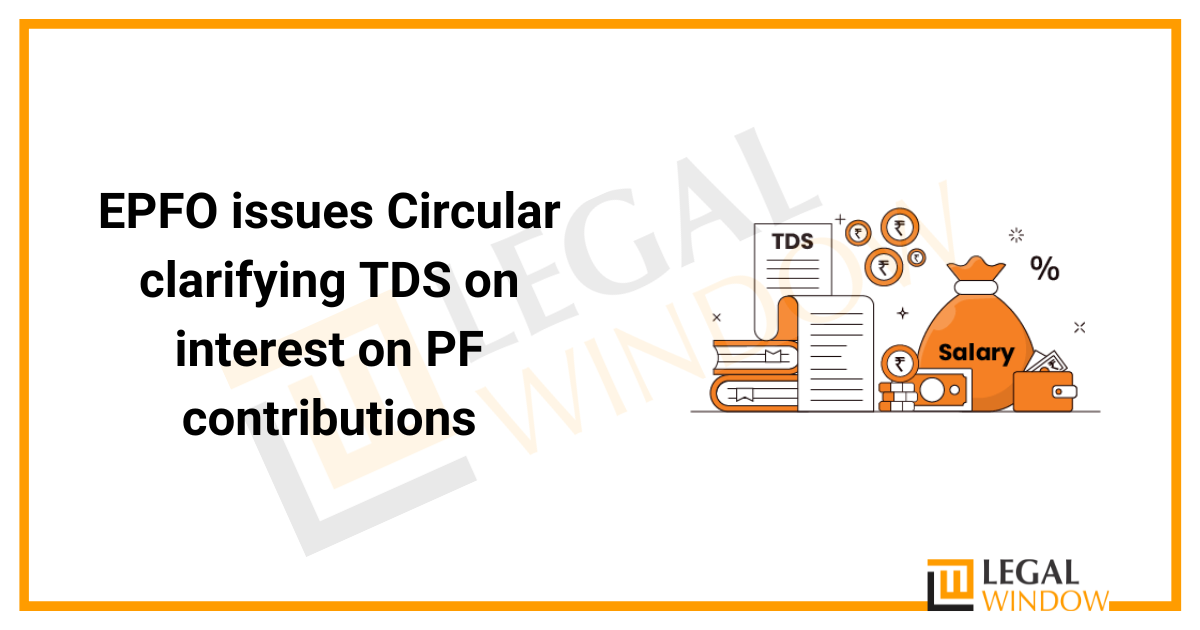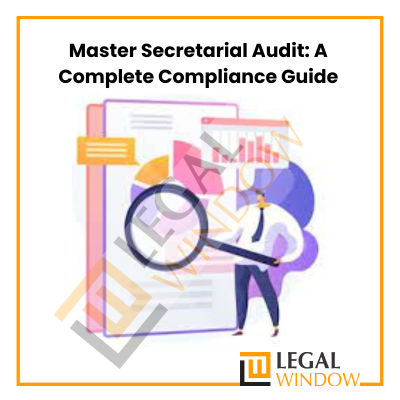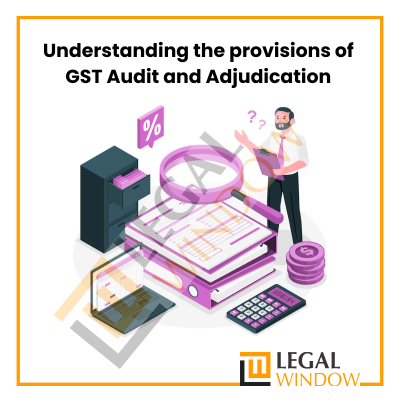EPFO issues Circular clarifying TDS on interest on PF contributions
- July 23, 2022
- Miscellaneous

The Employees’ Provident Fund Organization (EPFO) is a statutory agency established by the Indian government. As the largest social security institution in the country, it primarily encourages individuals to save for retirement, among other things. EPFO was created in 1951 and is managed by the Ministry of Labour and Employment. In this article we will discuss about EPFO issues Circular clarifying TDS on interest on PF contributions.
| Table of Content |
Key Abstract
The ‘Directive Principles of State Policy’ section of the Indian Constitution states that the State shall make effective provisions for securing the right to work, education, and public assistance in cases of unemployment, old age, sickness and disablement, and undeserved want within the limits of its economic capacity.
According to this declaration, a dynamic social security programme was required in the changing environment. As a result, legislation establishing a provident fund was enacted in an attempt to provide a dignified living for employees and their dependents when their job tenure ended.
The Employees’ Provident Fund (EPF) was established in 1951 with the passage of the Employees’ Provident Funds (EPF) Ordinance. The EPF Ordinance was ultimately repealed and replaced by the EPF Funds Act, 1952. The EPF Bill was proposed in parliament in 1952 to offer provident funds for factory and other business employees.
The Employees’ Provident Funds & Miscellaneous Provisions Act, 1952 is the new name for the law that oversees employees’ provident funds (also called The Act).
Structure of EPFO
The Central Board of Trustees oversees the administration of the Act and all of its programmes (EPF). The board is made up of members from the central and state governments, as well as companies and employees. The board is led by the Government of India’s Ministry of Labour and Employment. Three schemes are managed by the Central Board of Trustees (EPF).
- The Employees’ Provident Funds Scheme, 1952 (EPF)
- The Employees’ Pension Scheme, 1995 (EPS)
- The Employees’ Deposit Linked Insurance Scheme, 1976 (EDLI)
The EPFO is an organisation formed to support the Central Board of Trustees (EPF) and is administered by the Ministry of Labour and Employment of the Government of India.
EPFO Functions
EPFO aids the Central Board of Trustees (EPF) in the administration of a provident fund system, pension scheme, and insurance programme for registered establishments in India, including employees and overseas workers.
EPFO’s operations include
- Enforcement of the Act across the country
- Individual account maintenance
- Claims settlement
- Investing in funds
- Ensure timely pension payout
- Records are being updated
EPFO also serves as the focal point for the implementation of Bilateral Social Security Agreements with other nations. Furthermore, it is one of India’s largest social security organisations in terms of both beneficiary base and financial activities.
The Central Board of Trustees is the EPFO’s highest decision-making body. EPFO has taken a number of steps to simplify the operation of EPF accounts for both employers and workers by implementing IT-enabled tools and approaches. EPFO has recently launched a number of digital projects.
Overall, the EPFO has two functions: administration and oversight of the Act’s execution, as well as service provision to covered beneficiaries, i.e. members. The EPFO website provides information and online services.
Services by EPFO
The EPFO’s services include the following:
- Account Number Universal: EPFO established UAN, which serves as a catch-all for several member IDs assigned to one individual by various businesses. The UAN programme was introduced as part of the Pandit Deen Dayal Upadhyay Shramev Jayate Karyakaram in October 2014. It is possibly EPFO’s most spectacular step in recent memory.EPFO assigns a unique 12-digit number to each employee. Multiple EPF accounts (member IDs) assigned to a single member can be linked via UAN. Employees must activate their UAN via the UAN portal in order to use EPFO’s extensive online services.The UAN portal provides a variety of services, including a dynamically updated UAN card, an updated EPF passbook (including all transfer details), the ability to link previous member IDs with the current ID, SMS notifications regarding the credit of contributions in the PF account, and the ability to auto-trigger transfer requests on change of employment.
- Employee E-Sewa for UAN Members: Employees can register their UAN in the UAN Member e-Sewa portal and activate it to have access to the site’s services. Downloading a UAN card, updating KYC information online, obtaining an EPF account passbook connected to a UAN, submitting a transfer request, and more services are accessible.
- Online Helpdesk for Inactive Accounts: The EPFO website’s Inoperative Accounts’ Online Helpdesk was launched in February 2015, making it simple to seek down old or inactive inoperative EPF accounts. It assists EPF members in tracking down inactive PF accounts, settling them, or having them moved to the current account by supplying the bare minimum of information, such as former job to the degree known, as well as personal information. The service has been temporarily suspended.
- EPF Transfer Online: While EPF transfers were previously available online through the ‘Online Transfer Claim Portal,’ with the introduction of UAN, the transfer procedure has been updated and relocated to the ‘Unified Portal.’ This has made EPF transfers from one account to another simple, paperless, and trouble-free.
- Withdraw your PF Funds Online: An employee may withdraw PF if he or she is not working for 60 days after leaving a previous job. For UANs connected to Aadhar, EPFO has enabled online EPF withdrawal with a simple method.
- Establishment Registration Online: Has made EPFO establishment registration online. The PF code assignment letter is also made available online, which benefits an increasing number of employees.
- Online PF payments: EPF payments must be made online by all businesses. SBI, PNB, Indian Bank, Union Bank of India, Bank of Baroda, HDFC Bank, ICICI Bank, Axis Bank, and Kotak Mahindra Bank are among the banks that have partnered with EPFO to collect EPFO dues.
- For International Employees, centralised software is used to generate Certificates of Coverage: EPFO has established an online form, powered by its centralised software, to create Certificates of Coverage (CoC) for EPF members working in countries with Social Security Agreements with India.
- SMS/Alert Service and Missed Call Service: The SMS service and missed call service were introduced to provide EPF members who had activated their UAN with easier access to their EPF accounts. Members can obtain information about their KYC status, latest contribution, and total EPF balance by texting EPFOHO UAN followed by the first three letters of their selected language to 7738299899.Members can also access information by dialling 011-22901406. SMS alerts are also issued to members informing them of remittances, withdrawals, interest credit, and so forth. Additionally, SMS is issued to employers for non-deposit of dues.
- Electronic returns for exempted establishments – Use of an IT instrument: The e-return filing method makes it easier and less time-consuming for exempted enterprises to file their monthly returns.
- Passbook information and claim status: Members can examine their passbook and check the progress of their claims online. Members can also update/modify their basic KYC information online.
- Settling Grievances: Members/employers can also file a complaint online about EPF withdrawal, EPF transfer, pension settlement, and other issues. The resolution of grievances is given first attention. The number of pending cases has been reduced from 20,000 to 2,000-3,000 on any given day due to regular monitoring at the head office level, which is a miniscule figure when compared to the EPFO’s 15 crore accounts.The EPFO’s internet site contains links to several circulars. Circulars regarding the disclosure of the rate of interest for members on their EPF account, coverage of non-enrolled contract/casual employees in respect of Indian Railways, and so, on have recently been issued.
EPFO issues Circular clarifying TDS on interest on PF contributions
Employee Provident Fund Organisation (EPFO) released a circular on April 6, 2022, clarifying the calculation and deduction of tax on taxable interest linked to provident fund contributions under CBDT Notification No. 95 of 2021 Income Tax. This circular applies to all EPF subscribers beginning on April 1, 2022, for the fiscal year 2021- 22. According to the circular, the effective date for TDS in the case of final claim payment is:
- 01.04.2022 or, if later, final settlement/transfer,
In all other cases,
- TDS is due on the day of interest credit.
The CBDT announcement demanding tax deduction at source would be applied in the following circumstances:
- Settlement of PF
- Claims Transfer
- Transfer from exempted facility to EPFO or vice versa
- Transfer between trusts, transfer of prior accumulation, and
- Also relevant in circumstances of death involving a living member;
Explains the TDS computation technique, stating that the taxable portion of the contribution will be subject to separate accounting of interest and maintenance as the closing amount of the taxable portion will generate interest and be liable to TDS
As a result, for tax purposes, the interest on contribution and demand for refund should be separated into two components: taxable and non-taxable.
TDS must be calculated as follows:
- 10% if the PF account is connected to a verified PAN.
- 20% if the PF account is not connected to a valid PAN (i.e TDS rate would be double)
- 30 % under Section 195, subject to DTAA requirements; in the event of a non-resident. Furthermore, it will apply to international employees.
The calculation of taxable interest on contributions to a provident fund or recognised supplied fund that exceed the stipulated amount is provided in Rule 9D of the Income Tax Act, 1962.
If the second proviso to clause (11) or clause (12) of section 10 applies, the threshold limit is five lakh rupees; otherwise, it is two lakh and fifty thousand rupees.

Endnote
The EPF money is backed by the government, and the interest received is tax-free. EPF is classified as EEE (exempt-exempt-exempt). Under Section 80C of the Income Tax Act, the employee’s contribution is tax deductible. As a result, the money invested, the interest received, and the money that the employee finally withdraws after the obligatory defined term (5 years) are all tax-free. Hence, if utilized with care, provides much advantages to the person in their most crucial times.
Connect to Legal Window for more information about the Circular regarding clarifying TDS on interest on PF contributions.
Neelansh Gupta is a dedicated Lawyer and professional having flair for reading & writing to keep himself updated with the latest economical developments. In a short span of 2 years as a professional he has worked on projects related to Drafting, IPR & Corporate laws which have given him diversity in work and a chance to blend his subject knowledge with its real time implementation, thus enhancing his skills.
Categories
- Agreement Drafting (23)
- Annual Compliance (11)
- Change in Business (36)
- Company Law (148)
- Compliance (89)
- Digital Banking (3)
- Drug License (3)
- FEMA (17)
- Finance Company (42)
- Foreign Taxation (6)
- FSSAI License/Registration (14)
- GST (118)
- Hallmark Registration (1)
- Income Tax (199)
- Latest News (34)
- Miscellaneous (164)
- NBFC Registration (8)
- NGO (14)
- SEBI Registration (6)
- Section 8 Company (7)
- Start and manage a business (21)
- Startup/ Registration (127)
- Trademark Registration/IPR (40)
Recent Posts
- Master Secretarial Audit: A Complete Compliance Guide April 27, 2024
- Farmer Producer Companies-Major provisions under Companies Act April 26, 2024
- Detailed Analysis of Section 179 of the Companies Act, 2013 April 24, 2024
About us
LegalWindow.in is a professional technology driven platform of multidisciplined experts like CA/CS/Lawyers spanning with an aim to provide concrete solution to individuals, start-ups and other business organisation by maximising their growth at an affordable cost.







